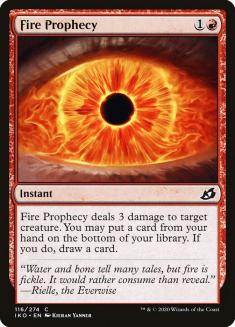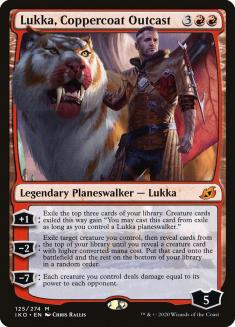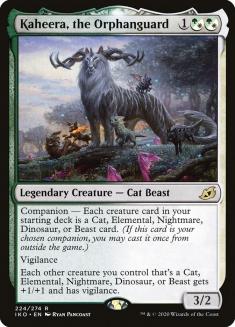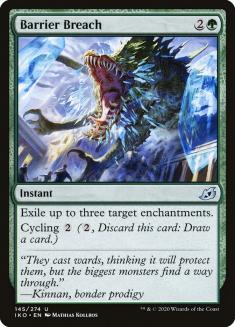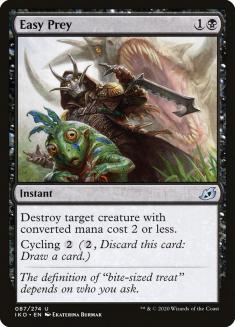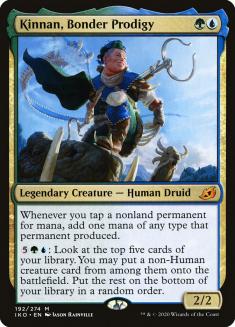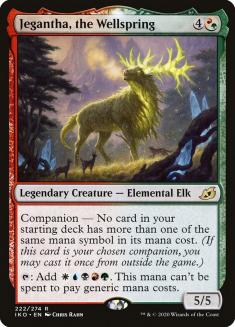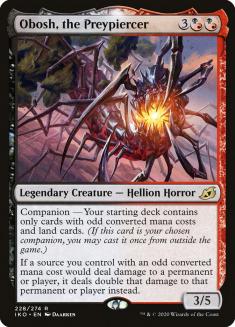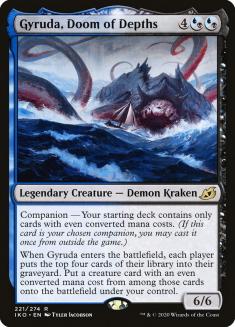Note: this article was written while listening to Vicetone’s “Astronomia” (the song in the dancing Ghanaian pallbearers meme) on repeat.
They really did a number on traditional metrics for judging new cards this time. Magic isn’t dead, not by a long shot, but it doesn’t quite look the same after Ikoria: Lair of Behemoths hits Constructed.
Powerful, narrow reactive cards all get cycling as an afterthought. Companion gets added to the pile of “whoopsie-daisies” alongside Phyrexian mana; Oko, Thief of Crowns; Skullclamp; and more. Mutate is one of the most complex (and least-grokkable, to use a Mark Rosewater-ism) keyword mechanics ever printed. We’re in for a brave new world when it comes to evaluating these, as they add a strange and unique axis to the game that we’ve never properly considered.
In Pioneer, Magic’s newest and most dynamic eternal format, these newcomers are going to turn things over immediately, pushing out old cards and upending half the metagame. Some of the milder candidates are simple upgrades to interactive spells that might have previously been marginal sideboard material. Many are likely maindeckable now.
Cheap cards with cycling also alter our baseline for land counts, as any deck can now happily include a handful of one-mana cantrips. It’s going to be easier than ever to justify shaving a land or two, or at least it would were it not for the presence of companions as our virtual eighth cards to mitigate mana flood every game. After all, when you start every game with a spell in your back pocket, keeping four or even five lands doesn’t seem nearly as bad.
These all portend a paradigm shift in deckbuilding, just one more out of many we’ve seen in the span of a year and a half since the FIRE design philosophy really started moving forward.
For evaluating the most powerful, metagame-warping cards in Ikoria for Pioneer, there are a number of factors to consider, but ubiquity and likelihood of getting banned are evergreen metrics. And make no mistake, some of these cards will get banned.
Honorable Mentions
I’m interested in Fire Prophecy as an interactive spell that offers a narrow subset of decks the under-explored “Vendilion Clique myself” effect. Some decks play cards that they never want to draw. We’re talking about Emrakul, the Aeons Torn in Polymorph decks; Progenitus in Natural Order decks; Elesh Norn, Grand Cenobite in Gifts Ungiven / Unburial Rites decks; and more. Lukka offers us a second Polymorph-esque effect in red, alongside Indomitable Creativity. Dwarven Mine offers a freebie source of a token to hit and turn into a monster, and Fire Prophecy lets you rid yourself of a pesky in-hand payoff card. Now, the only limiting factor in Pioneer is finding strong enough payoffs and more ways to consistently present a token without including any non-huge creatures in the deck.
(Although, depending on which giant creature you come up with, there are options for a companion like Zirda, the Dawnwaker to provide a free body to upgrade. Just one more feather in the cap of the companion mechanic!)
We all know that Fire Prophecy is a stellar card for a deck like Dredge in Modern, but it offers a unique effect that’s sorely under-printed, and it’s going to be a player to some degree in Pioneer.
10. Kaheera, the Orphanguard
No, Cat tribal is probably not going to become a major player in Pioneer. Sorry to disappoint. It might become a fringe-playable deck, as an extra lord every game is worth building around (at least once some of the more powerful companions are banned). Aside from the obvious tribal strategies, though, Kaheera has a loose restriction that gives a free 3/2 creature with vigilance to any deck that plays zero (or a very few specific) creatures in the maindeck. If you’re a creatureless Bant Control deck, you can play Kaheera as your companion for a free piece of cardboard. You can even sideboard into a creature strategy with Questing Beasts and other creatures that fit the restriction more effectively.
This pivot power from a creatureless deck with eight cards in the opening hand to a creature plan that always has at least one piece at the ready is actually quite impactful on deckbuilding. Against a fully creatureless deck, it’s easy to sideboard out removal spells for more Negates or Mystical Disputes. Against a Kaheera deck, you’re always going to be second-guessing yourself when trying to determine what to do with your sideboarding.
Discard spells and narrow countermagic are no longer as effective in control mirrors. Keep that in mind as you continue to explore Pioneer moving forward.
9. Barrier Breach
The first of a few narrow cards with cycling that are worth considering in Pioneer, Barrier Breach is worth putting in your sideboard to come in against Mono-White Devotion and their heavy load of enchantments. The three-for-one isn’t always possible, but you’re often going to hit two permanents and make life difficult for them. And if you draw it when the opponent isn’t running out a bunch of Stasis Snares and Heliods? Just cycle it away; the opportunity cost is low.
Barrier Breach is one of several newly printed cards that just two years ago would have been printed without cycling, but in the new era of Best-of-One matches driven by MTG Arena, it’s being pushed along with the next card on this list. This isn’t necessarily a bad thing at all, just a new way to balance interactive spells given the constraints of best-of-one play. Unlike Wilt, which is even more flexible and is likely playable in Lotus Breach’s starting 60, Barrier Breach isn’t worth maindecking in current Pioneer yet, but if enough enchantments start cropping up it just might get there. For now, keep it in the sideboard of your green decks to blow out opponents who play too many enchantments.
8. Easy Prey
This one is an easy maindeckable inclusion for Dimir Inverter. As a supplementary removal spell, it covers opposing copies of Jace, Vryn’s Prodigy when you don’t draw a Fatal Push. It covers Pack Rat out of the sideboard, and cycles in the late-game or when a removal spell isn’t necessary.
It’s also stellar in Esper Control, offering additional density of removal spells while providing velocity in a pinch. Cards like this are always solid additions to the menu of spells when building interactive decks in an eternal format.
When you’re not sure if your opponent is going to do something unexpected, a hedge is never a bad idea. Easy Prey smooths out draws, acting as a bad Fatal Push / Opt split card. Those will never go out of style.
7. Kinnan, Bonder Prodigy
The most speculative card on the list, Kinnan is sort of like a Leyline of Abundance for Simic Devotion, the deck that was mostly kept down by a multitude of bannings. Leyline, Oath of Nissa, Oko, and even Once Upon a Time all got axed to dent the consistency and power of this explosive deck. Kinnan offers a similar effect to Leyline of Abundance without needing to be in the opening hand to be truly powerful. It comes down early, and if it’s not answered, suddenly a lot of mana starts coming around. With lots of creatures that tap for mana to play out in the early turns, Kinnan is both a much-needed mana boost and a mana sink.
Decks like Mono-Green Devotion and associated archetypes are critical mass decks, that is, they rely on a certain amount of on-the-battlefield pieces interacting to overpower the opponent with expensive spells. But they’re also critical mass decks in that they rely on a certain quantity of powerful enough enablers and payoffs to be legal simultaneously in order to go from unplayable to dominant. Pioneer already had a too-powerful Mono-Green Devotion strategy for a number of months. Kinnan will be a piece of the puzzle to put it back on the board.
6. Heartless Act
Shaheen Soorani said it best —Heartless Act is the best black removal spell since Fatal Push. It’s going to be a two-of in countless fair decks across multiple formats, but Pioneer might be where it ends up being best. In Standard, there are likely to be a decent number of creatures with counters hanging out on them to mitigate Heartless Act’s universality, but in Pioneer the same high-quality threats will remain played.
In that case, Heartless Act is the universal answer we’ve been searching for. It kills nearly every creature in the format, no questions asked. That’s great, a classy addition to a new set that will give more interaction to more decks. No one can be upset about the printing of a card like this, and many people will be absolutely thrilled. Clearly, if it weren’t for some cards that got pushed far too hard, we’d have a wonderful set on our hands and could stop here. But the folks at Play Design got a little out of control with companion, and some forthcoming cards are just going to fundamentally change the game.
5. Jegantha, the Wellspring
The least restrictive of all the companions, Jegantha is a total freeroll in a number of Pioneer decks. Our own Paulo Vitor Damo da Rosa pointed out several archetypes where it requires nothing more than a single sideboard slot to include, and the best one, Five-Color Niv-Mizzet, where it only asks for a minor sacrifice in card selection.
In exchange, Jegantha offers a free extra card. It casts Niv-Mizzet Reborn on its own. It attacks and blocks, and it can’t be Thoughtseized. An opponent looking to disrupt you can no longer rely on one-for-ones, because every single game is going to include an on-curve Turn 5 play, no matter what.
And yes, it goes in Bant Spirits and Izzet Ensoul for free. In exchange, these decks now have an extra threat they can run out if they draw more lands than they would like.
Is Bant Spirits on eight cards now just a solid favorite against Dimir Inverter on seven? Even if one is kind of bad and non-synergistic? It’s possible.
Are we going to see Jegantha suit up with a Shadowspear and a Ghostfire Blade and smash face out of Izzet Ensoul? Almost certainly. All of the above decks got a massive free upgrade, and it would shake up the format, except for the fact that there are a bunch of other companions in the arms race for other archetypes.
4. Yorion, Sky Nomad
This one’s got a weird restriction: you have to play with twenty extra cards. Patrick Chapin thirteen-year-old article about playing 66-card Mystical Teachings might be instructive here.
But cards have gotten better since the Bush Administration and Yorion is sort of like a Battle of Wits that always starts in your opening hand (as an extra card, to boot!)
Sam Black is playing this one in Modern, which shows how powerful the effect is, but in Pioneer it’s a little less cut-and-dried. I’d like to explore the Orzhov Enchantments deck similar to the one Gabriel Nassif has been playing with recently:
But such a strange and unique restriction tied to a strange and unique creature deserves lots of exploration. Will it be part of a thick Mono-White Devotion deck with Arcanist’s Owls galore? Or will something entirely new crop up? This is likely to be the most fun of any companion, without a doubt.
3. Obosh, the Preypiercer
Ah, almost balanced! Obosh is just a smidge too strong in Mono-Red decks, where it essentially acts like a Torbran, Thane of Red Fell that you kept in your lap at the beginning of the game. Why is this fair? You get to palm a five-mana Torbran in exchange for playing Shock over Lightning Strike? Gross.
Andrew Jessup came up with a stellar first draft of Obosh Red, and it’s going to be my go-to deck for grinding Magic Online (MTGO) Leagues for the foreseeable future:
Creatures (24)
- 4 Goblin Rabblemaster
- 4 Monastery Swiftspear
- 4 Bomat Courier
- 4 Soul-Scar Mage
- 4 Rampaging Ferocidon
- 4 Bonecrusher Giant
Lands (24)
Spells (12)

Easy wins. If Llanowar Elves comes back in a big way, we can move more on Forge Devil and Goblin Chainwhirler. It’s also possible that we want more one-drops like Ghitu Lavarunner and to pick up Wizard’s Lightning. A 25th land wouldn’t even be a terrible idea, what with our five mana curve-topper and our seven utility lands.
This is the strongest aggro deck in Pioneer now.
2. Gyruda, Doom of Depths
This one already got temporarily banned on MTGO for rules infractions. It just doesn’t play nicely with the game’s rules engine, to be frank. But the combo deck with Gyruda is something to see.
Creatures (35)
- 4 Clone
- 2 Progenitor Mimic
- 4 Sylvan Caryatid
- 4 Clever Impersonator
- 2 Dragonlord Kolaghan
- 4 Altered Ego
- 4 Vizier of Many Faces
- 4 Paradise Druid
- 4 Spark Double
- 3 Gyruda, Doom of Depths
Lands (23)
Spells (2)
Sideboard

Everyone is going to need to adopt Grafdigger’s Cages, and quickly. The one saving grace is that Gyruda stops you from playing some of the better answers to Grafdigger’s Cage, though Wilt is an incredible pick-up from the new set. Steelbane Hydra is the only even-costed creature that destroys artifacts in our colors in Pioneer, though there are plenty of noncreature answers we can pick up.
As it currently stands, Gyruda Combo and Obosh Red are the easiest first drafts to abuse this new mechanic in Pioneer. One companion stands head and shoulders above the rest on raw power level, though, and it’s certainly going to push things in an interesting direction for Pioneer (and every other format it’s legal in).
1. Lurrus of the Dream-Den
Andrew Elenbogen said it. Sam Black said it. Now I’m saying it. Lurrus is just plain broken. Imagine if we got an Eternal Witness companion. That would be mighty good, no? This is an Eternal Witness companion that brings back something every turn. It also has +1/+1 and lifelink. Remember, this card starts the game in your opening hand as an eighth card.
I don’t understand. The restriction is that you have to play only cheap permanents? You mean the restriction that we’ve been secretly getting acclimated to over the course of the last two years as the cards just keep getting cheaper and more powerful?
A weird cross between Emry, Lurker of the Loch; Eternal Witness; and Cheatyface, Lurrus is destined to hit the showers swiftly. I repeat myself. This is going to get banned soon across multiple formats. Play it until you break it, and then rack up wins until it does.
And that basically sums up Ikoria in Pioneer. Play the companions, break them one by one, show Play Design the error of their ways, and then we can maybe get back to enjoying some of the more normal answer cards that should be the permanent footprint of this set on the game.



